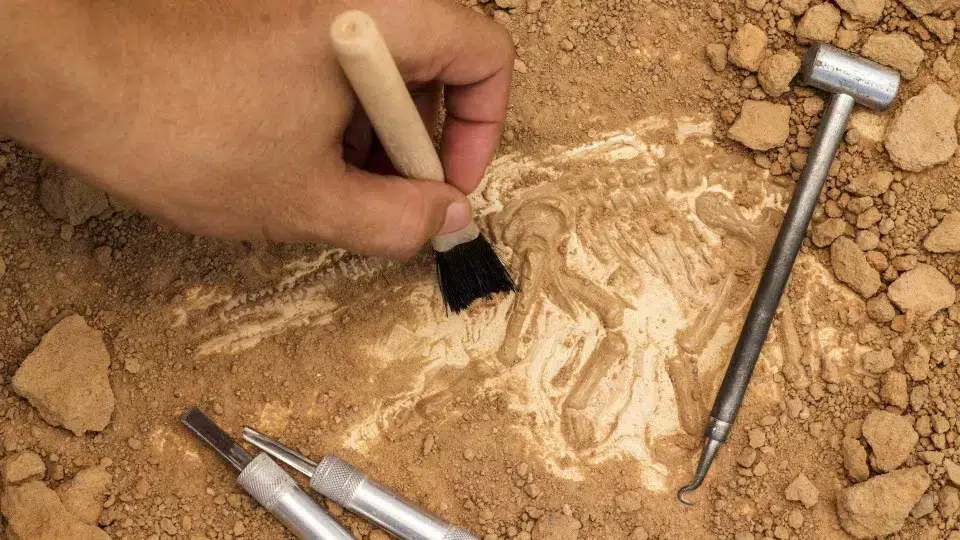
The rare dinosaur skull has enabled an international team to describe a new species of iguanodont dinosaur (herbivorous and bipedal) called ‘Cariocecus bocagei’, the first named iguanodont species from the Portuguese Lower Cretaceous period.
“The ‘Cariocecus’ has a unique characteristic among dinosaurs: the jugal bone (analogous to the cheekbone) and the maxilla are fused, an adaptation likely designed to strengthen its chewing,” explains Filippo Bertozzo, an author of the study from the Royal Belgian Institute for Natural Sciences and the Natural History Society of Torres Vedras (SHN), as noted in a press release.
Although three other iguanodont species have been identified in Portugal’s Upper Jurassic (‘Draconyx loureiroi’, ‘Eousdryosaurus nanohallucis’, and ‘Hesperonyx martinhotomasorum’), before this study, “fossils of iguanodonts from the Lower Cretaceous were rare, uninformative, and very primitive.”
Bruno Camilo, also an author of the study and director of SHN, states that this new species “represents the most complete dinosaur skull ever found in the country.”
“Because it is a young or subadult specimen, it allows us to understand the timing and modalities in which cranial bones co-ossified during growth, something very rare to comprehend in a dinosaur,” adds Camilo, also a Ph.D. candidate at the Instituto Superior Técnico.
The discovery contributes to a better understanding of their biology, especially regarding the origin and diversification of these animals during the Cretaceous.
The preservation and three-dimensionality of the find enabled the digital reconstruction of the brain, cranial nerves, and primarily the inner ear, revealing a short olfactory lobe and a large brain.
In addition to unique cranial features, American Donald Cerio, another author of the study and researcher at Johns Hopkins University, highlights “fossil evidence of neurosensory structures, including the cavities of the brain, ears, and eyes,” to explain its evolution and diversity in the Lower Cretaceous.
The study could help discover new information about dinosaur metabolism.
“We are increasingly deepening our understanding of the sensory capabilities of dinosaurs, with the exceptional preservation of the endocast allowing us to better understand the details of the ears and hearing of these animals,” clarifies Ricardo Araújo, another author and researcher at the Instituto Superior Técnico and SHN.
The skull was found in 2016 on the coast of Sesimbra, in the district of Setúbal, by Pedro Marrecas, co-author and researcher at the Natural History Society of Torres Vedras, where they were stored.
At Praia da Área do Mastro, the fossil was “partially visible in the rock block, thanks to the row of protruding teeth” and required preparation and restoration work.
In this region, other dinosaurs have been discovered, but none had the necessary characteristics to be considered a new species.
In Portugal, “we have an abundant diversity of similar animals from even older epochs, from the Upper Jurassic, but more primitive, not yet within the iguanodont lineage. Portugal proves to be an important ‘bridge’ between these geological periods, which will allow us to unravel the secrets of the iguanodonts’ evolutionary success,” says Filippo Bertozzo.
Scientists named the new species ‘Cariocecus bocagei’, alluding to the ancient war deity revered by local populations in the pre-Roman period (Cariocecus) and in homage to José Vicente Barbosa du Bocage, a 19th-century Portuguese naturalist (‘bocagei’).
The study is also authored by José Carlos Kullberg (Universidade Nova de Lisboa), Fabio Manucci (Italy), Victor Feijó de Carvalho (SHN), Silvério D. Figueiredo (Instituto Politécnico de Tomar), and Pascal Godefroit (Royal Belgian Institute of Natural Sciences).




